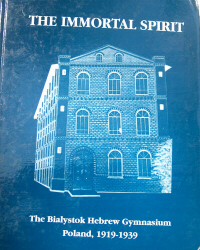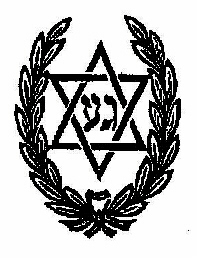Page 147
The period of Soviet rule came to an end when Eastern Poland was
invaded by the Nazi Armies. The first bombs fell on Bialystok on 27
June 1941. Thousands of Jews, who realized what was in store for them,
fled to the east. Many of them were killed on the roads by bombs
dropped by German aircraft, others were shot by German soldiers, and a
few managed to return to Bialystok. Amongst those who fled and did not
return were Physics teacher Tauman and Maths teacher and former
Gymnasium graduate (Fourth Graduation Year) Novodworski. It was
rumoured that they both died on the roads.
The Polish inhabitants of
the region had been waiting for an opportunity to attack the Jews, and
during that month, six hundred Jews from Bialystok were killed by the
Poles. In his memoirs, Dr. Shimon Dattner listed the names of those
Gymnasium teachers who remained in Bialystok: A. Aharonowitz, M.
Chazanowitz, Moshe Zabludowski, Dr. F. Horowitz, Chaim Sheffer, Miss
R. Solomon, Magister N. Kaplan, G. Shkolnikow, D. Patziner, A. Bomchil,
Magister Yaacov Shnapper, Dr. Shimon Dattner, Y. Rotberg, Magister
Pnina Berstein, Shmuel Rakowski, S. Yakobowski, and Magister Hadassah
Sprung, (Chaim Welger and his family left Bialystok and returned to
Galicia. Dattner heard later that Welger's wife and daughter perished
in the Lvov ghetto).
On 27 June, the Germans herded two thousand Jews
into the Great Synagogue and burnt it to the ground. Dr. Dattner
recorded that on Thursday 3 July, the Germans led two hundred Jews from
the intelligentsia to the forest and shot them to death. One of those
killed was Hebrew teacher Y. Rotberg. In the ghetto, they referred to
those who died as "Die Donnershticke". Ten days later, on Saturday 12
July, the S.S. shot four thousand Jews in the Paytroshi forest. Moshe
Zabludowski was one of those killed. People in the ghetto called them
"Die Shabbasdicke". It was at that time that Pesach Kaplan wrote the
song "Rivkele Die Shabbasdicke". The Bialystok ghetto was set up at
the end of July 1941, and in August of that year it was forbidden to
enter or leave it.
In a number of small streets, surrounded by barbed
wire fences, were imprisoned all the city's Jews and thousands of Jews
from the provinces. The transports commenced on 18 September 1941. In
the first transport, four thousand Jews were deported to Prozani. In
November 1942, the Germans killed Jews throughout the region, but did
not yet destroy the Jews in the Bialystok ghetto. More than seventeen
thousand Jews were employed in factories in the ghetto, manufacturing
clothing, hats, and shoes for the German Army. The Judenrat concluded
that this employment would save the lives of the workers, and the Head
of the Judenrat, Engineer Alexander Barash, said: "We will purchase
our lives by working". Only one of the Gymnasium's founders avoided
the fate of the Jews of Poland. Dr. Moshe Zieman emigrated to Eretz
Yisrael in 1939 (his son by his first marriage, who had settled in
Germany, was killed by the Nazis. His first wife and his daughter, who
remained in Poland, perished in the ghetto). Dr. Moshe Katznelson was
appointed as Head of the Health Department in the ghetto, and later, in
his capacity as a doctor, was sent to Teresienstadt with a group of
children, and from there to Auschwitz.
Mendel Kaplan was appointed to
be a member of the Judenrat. In the ghetto, Eliezer Kahana continued
to deal with the administrative affairs of the Jewish Hospital.
Members of the youth movements and the "Bund" set up a Joint Committee,
organized groups of partizans, and smuggled Jews into the forests.
Rumours of what was happening in the concentration camps caused alarm,
and many preferred not to believe them, but in January 1943, a Jew who
had escaped from Treblinka reached the ghetto and delivered an
eye-witness report.
The Joint Committee organized an underground in the ghetto, and
partizans who were hiding in the forest supplied it with arms and
instruction. One of the underground leaders, Ephraim (Paul) Olcha
(Oren), had been a Gymnasium student, one of five brothers who had
studied there. He and his brothers had played in Shkolnikow's brass
band. In the ghetto, Paul married the daughter of Berl Subotnik, the
Gymnasium's secretary. Gymnasium student (Thirteenth Graduation Year)
Chaike Grossman (later Member of the Israeli Parliament and of Kibbutz
Evron) acted as a courier between the ghettos. Thanks to her
"non-Jewish" appearance, she was able to leave the ghetto and travel
freely. In an apartment which had belonged to Chaim Welger before the
German invasion, a sort of teachers' "Kolkhoz" existed. Dattner listed
the names of the "Kolkhoz" residents: Gymnasium teachers Franca
Horowitz, Hadassah Shprung, Yaacov Shnapper, Shimon Dattner, and other
teachers and their families. "From all these", wrote Dattner, "only
Hadassah Shprung and I survived".
In February 1943, members of the
underground tried to oppose an "aktion" (a round-up of Jews for
transport to the death camps) with force, and killed a few Germans.
Following this, two thousand Jews were killed in the ghetto, and twelve
thousand were sent to Treblinka. The "aktion" continued for seven
days, from 5th to the 12th of the month. Amongst those who were killed
was Chaim Sheffer, Maths teacher Bomchil, and the Judaic Science
teacher D. Patziner. On 5 February, Dr. Franca Horowitz committed
suicide; she had been ill, could not stop coughing, and refused to hide
in a bunker and endanger the lives of others. On 15 August, news
spread that the Germans were about to send the remaining forty-five
thousand Jews who still survived in the ghetto to the death camps.
Mendel Kaplan died of a heart attack at his desk in the Judenrat office
when he was informed of this. Members of the underground distributed
pamphlets calling on the Jews to resist the deportation, but few
responded to their call. The last struggle of the underground in the
Bialystok ghetto commenced on 16 August 1943, and lasted for several
days. Almost all of its members were killed by the Germans. The date
of Ephraim (Paul) Olcha's death is known; the 20 August. He was
twenty-two years of age.
The Jews were sent to the death camps at
Treblinka, Poyniatek, and Maidanek. Bialystok was "Judenrein" (free of
Jews).
When the last transports had left the ghetto, the
Ukrainians entered it, searched for and found those few Jews who had
survived in hiding-places, and handed them over to the Germans.
Amongst those who perished was Historian Avraham Shmuel Hershberg,
author of "The Bialystok Notebook". Eliezer Kahana, one of the
Gymnasium's founders, was killed together with the staff of the Jewish
Hospital. Teacher Pnina Berstein, her husband, and baby son, perished
in one of the camps. Dr. Moshe Katznelson died in Auschwitz. David
Braver perished in the Grodno ghetto. Gymnasium student Avraham
Kaplinski, who was a member of the underground, was handed over to the
Germans by Poles in 1944, a few weeks before the Germans retreated from
Poland.
Following, are the testimonies of two people who were in the ghetto:
Hebrew Gymnasium teacher Hadassah Shprung, who was the secretary of the
Judenrat, and Gymnasium graduate Chaike Grossman, a member of the
underground.






